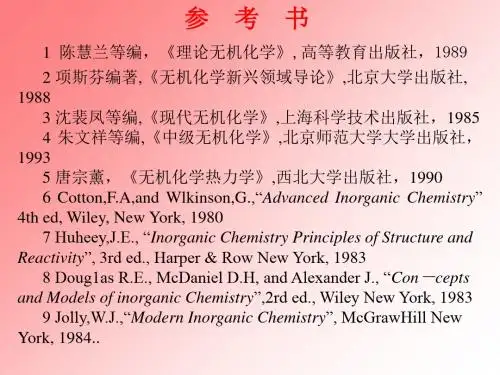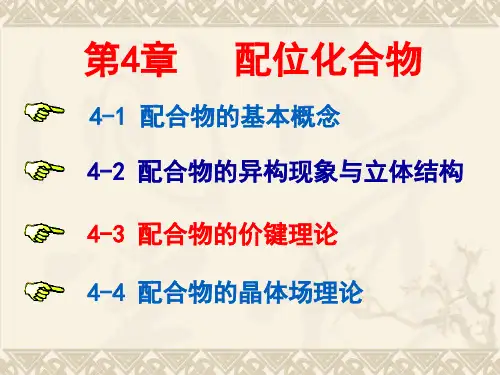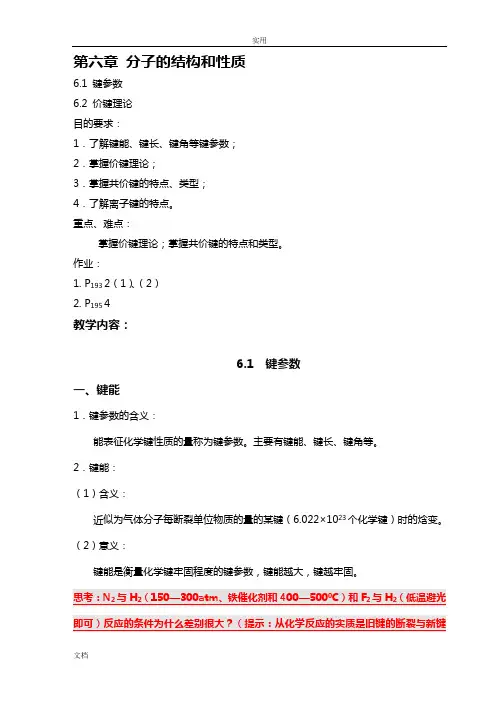无机化学双语教学资料
- 格式:doc
- 大小:2.72 MB
- 文档页数:76





第六章分子的结构和性质6.1 键参数6.2 价键理论目的要求:1.了解键能、键长、键角等键参数;2.掌握价键理论;3.掌握共价键的特点、类型;4.了解离子键的特点。
重点、难点:掌握价键理论;掌握共价键的特点和类型。
作业:1. P193 2(1)、(2)2. P195 4教学内容:6.1 键参数一、键能1.键参数的含义:能表征化学键性质的量称为键参数。
主要有键能、键长、键角等。
2.键能:(1)含义:近似为气体分子每断裂单位物质的量的某键(6.022×1023个化学键)时的焓变。
(2)意义:键能是衡量化学键牢固程度的键参数,键能越大,键越牢固。
(3)计算:双原子分子:键能等于键解离能(D)多原子分子:键能等于同种键逐级解离能的平均值。
二、键长1.含义分子内成键两原子核间的平衡距离,用L b表示。
可用分子光谱或X射线衍射方法测得。
2.决定因素:(1)内因:成键原子的本性(2)外因:相同原子形成不同类型化学键时具有不同的键长3.意义:相同原子形成不同化学键时,键长越短,键能越大,键越稳定。
三、键角1.含义:在分子中两个相邻化学键之间的夹角。
可用分子光谱和X射线衍射实验测得。
2.意义:根据分子内全部化学键的键长和键角数据,可确定分子的几何构型。
6.2 价键理论一、共价键1.共价键的形成原子间由于成键电子的原子轨道重叠而形成的化学键。
2(1)理论基础以相邻原子间电子相互配对为基础。
(2)理论要点A.组成分子的两个原子必须具有未成对的电子,且它们的自旋反平行,即原子中的1个未成对电子只有以自旋状态反平行的形式与另一个原子中的1个未成对电子相B.原子轨道相互重叠形成共价键时,原子轨道要对称性匹配,并满足最大重叠的条件。
即自旋方向相反的未成对电子相互接近时,必须考虑其波函数的正、负号,只有同号轨道(对称性匹配)才能实行有效的重叠C.原子轨道重叠时,总是沿着重叠最大的方向进行,重叠部分越大,共价键越牢固,这就是原子轨道的最大重叠条件。
无机化学双语教学 参考资料(上册)
班 级:050911 指导教师:夏 平 教 师:吕春燕 Main Contents of Inorganic Chemistry: Ⅰ Theory (first term) Equilibrium: chemical equilibrium (base); dissociation equilibrium; precipitation and dissolution equilibrium;
hydrolysis equilibrium; redox equilibrium; complexing equilibrium. Structure: atomic structure; molecular structure; crystal structure.
Ⅱ Element chemistry (second term) the properties, preparations and
applications of elements and compounds
Chapter One Mass Relationship and Energy Relationship in Chemical Reaction
Central contents: 1. Understand the concepts of state function、heat、work、enthalpy and change in enthalpy; 2. Know well how to write chemical equations and how to use Hess’s Law; 3. Use standard molar enthalpy of formation to calculate chemical enthalpy of reaction
Section One Basic Concepts
1.Thermochemistry, thermodynamics Thermochemistry: the study of the quantitative relationship between heat and other energy in chemical reactions Thermodynamics: the study of the conversion and transfer of incidental energy in chemical or physical changes 2.System and surroundings When we analyze energy changes, we focus our attention on a limited and well-defined part of the universe. The portion we single out for study is called the system, everything else is called the surroundings. There are three types of systems: Open system can exchange mass and energy (usually in the form of heat) with its surroundings. Closed system allows the transfer of energy (heat) but no mass. Isolated system does not allow the transfer of either mass or energy 3.State function A property of a system that is determined by specifying its condition or its state (in terms of temperature, pressure, location, and so forth). The value of a state function does not depend on the particular history of the sample, only depends on its present condition. For example: U, n, T, V and p are said to be state functions - properties that are determined by the state the system is in. pV = nRT R: molar gas constant(8.314 J·K-1·mol-1) Characteristics: 1). When the system’s state is specified, we can give a state function a certain value. 2). When the system’s state is changed, the value of a state function only depends on its initial state and final state, doesn’t depend on the particular history of the system. 3). When the system comes back to the beginning state, the value of a state function will return to the initial magnitude.
4. Heat and work Energy is transferred in two general ways: to cause the motion of an object against a force or to cause a temperature change. Heat is the energy transferred from a hotter object to a colder one (between system and surroundings because different temperature). It is symbolized by symbol Q. Work is the other way energy is transferred between system and surroundings. It is symbolized by symbol W. The SI unit of Q or W is J (1J=1kg.m2/s2) pv work: the work transferred between system and surroundings as the volume of system is changed. W = -p (V2 – V1) = -p∆V So W (expand)<0 W (compress)>0 Note: Q and W are not state functions Symbol and units: Units: kJ, J Heat absorbed by the system from the surroundings Q>0 positive (endothermic process) Heat absorbed by the surroundings from the system Q<0 negative (exothermic process) Work done by system on the surroundings W<0 negative Work done on system by the surroundings W>0 positive 5. Thermodynamic energy(internal energy) The internal energy of a system has two components: kinetic energy and potential energy. The kinetic energy consists of various types of molecular motion and the movement of electrons within molecules. Internal energy is symbolized by symbol U (a state function), so in a system, the value of ∆U only depends on its initial state and final state, doesn’t depend on the particular variational process.
∆U = Ufinal - Uinitial =U2 – U1 If U2 >U1 ∆U>0 system has gained energy from its surroundings or heat is absorbed If U2 < U1 ∆U<0 system has lost energy to surroundings or heat is given off 6. Law of conservation of energy All forms of energy can be changed (at least in principle) from one form to another. We have also seen that energy can be transferred back and forth between a system and its surroundings in the forms of work and heat. One of the most important observations is that although energy can assume many different forms, energy can be neither created nor destroyed. When one form of energy disappears, some other forms of energy (of equal magnitude) must appear, and vice versa. The total quantity of energy in the universe is thus assumed to remain constant. This statement is generally known as the law of conservation of energy. The first law of thermodynamics describes the conservation of energy; it states that energy can be converted from one form to another, but cannot be created or destroyed. The algebraic expression of first law of thermodynamics is: ∆U = Q + W. The signification is in a closed system, when it undergoes any chemical or physical change, the accompanying change in its internal energy, ∆U, is given